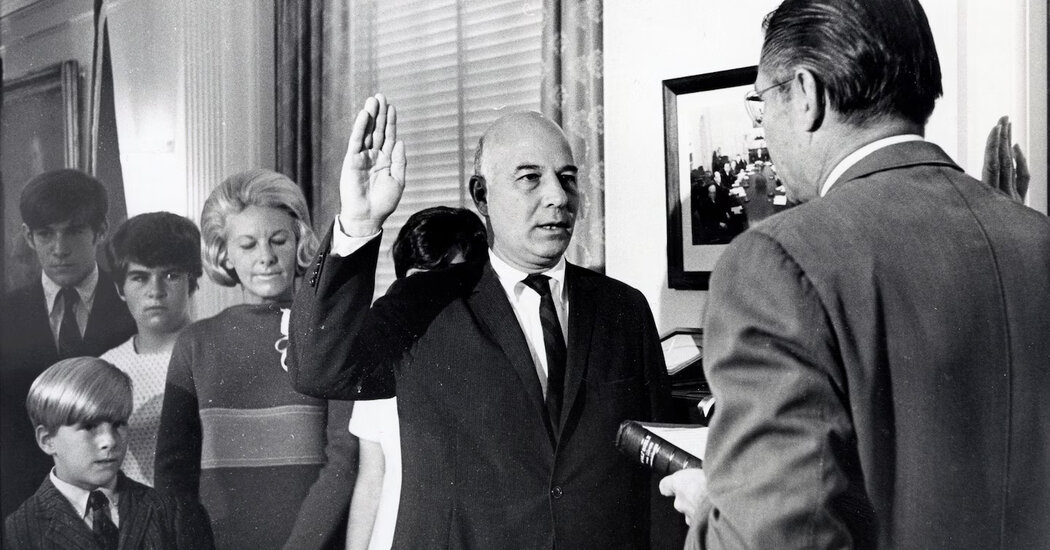Copyright The New York Times

Paul R. Ignatius, a son of Armenian immigrants who became secretary of the Navy and helped oversee Defense Department supply chains during the Vietnam War — “everything from mayonnaise to missiles,” he said — died on Thursday at his home in Washington. He was 104. His son David Ignatius, the international affairs columnist for The Washington Post and a novelist, confirmed the death. In his post-government career, Paul Ignatius served two years as president of The Post and executive vice president of The Washington Post Company at a contentious time surrounding the release of the Pentagon Papers. A Navy combat veteran of World War II, Mr. Ignatius was a Harvard-educated management consultant whose firm, based in Cambridge, Mass., specialized in military contracts. He joined the Defense Department in 1961, during the Kennedy administration, as assistant secretary of the Army for logistics at a time when the United States had become increasingly embroiled in the Vietnam War. Defense Secretary Robert S. McNamara, the former Ford Motor Company president who had recruited Mr. Ignatius as one of his “whiz kids” from the world of business and analytics, called him “one of my most valued and trusted associates.” Starting in 1964, Mr. Ignatius spent five years as assistant secretary of defense, continuing to focus on supply chains and preparing ports and bases from which to stage the war in Southeast Asia. “At home, there was tension in the family as my children and my wife all thought the war was a bad idea,” he said in a 2017 interview with the English-language magazine AGBU, published by the nonprofit Armenian General Benevolent Union. “They thought the policy of the United States at the time was wrong, and, while I disagreed, I am proud that my children were thinking for themselves. I had colleagues whose family relationships suffered, but we survived it.” He was tapped as secretary of the Navy in 1967 after the secretary-designee, John T. McNaughton, died in a plane crash. Mr. Ignatius’s two-year tenure coincided with the North Korean seizure of the Pueblo, a Navy intelligence ship, in January 1968 in what were thought to be North Korean waters. One of the Pueblo’s 83 crew members was killed, and the others were released after being held for several months in a North Korean prison. The incident led to a Navy court of inquiry over the actions of five officers; it recommended two courts-martial, two letters of reprimand and a letter of admonition. Mr. Ignatius’s successor, John H. Chafee, who was later a Republican senator from Rhode Island, ultimately ended the proceedings and blocked the courts-martial, saying the months of captivity were sufficient punishment. After leaving government service in 1969, when Richard M. Nixon became president, Mr. Ignatius was named to his executive roles at The Post on the recommendation of Mr. McNamara, a close friend of the publisher, Katharine Graham. Over the next two years, Mr. Ignatius found himself besieged by labor negotiations and on the losing side of important business and journalism decisions. Most notably, he had argued unsuccessfully for delaying the publication of the Pentagon Papers, the top-secret Defense Department documents that traced the history of U.S. involvement in the Vietnam War and that had first been obtained and published by The New York Times. Although the documents were commissioned by Mr. McNamara under President Lyndon B. Johnson, the Nixon administration sued The Times in June 1971 to suspend further publication. Mr. Ignatius, along with several Post lawyers and another top business-side executive, argued against publishing the papers. They were wary of wading into a legal morass as The Post was about to go public as a company and were concerned that defying the White House would adversely affect the share price. Mrs. Graham, however, sided with the newsroom, led by Benjamin C. Bradlee, the executive editor, who argued for publication. The decisions by The Times and The Post to write about and print the documents led to a landmark Supreme Court ruling that year affirming the First Amendment right of news organizations to publish without prior restraint by the government. “Paul was a thoroughly nice, well-intentioned man, but he came from a very different culture and never really learned the communications business,” Mrs. Graham wrote decades later in her Pulitzer Prize-winning memoir, “Personal History.” Paul Robert Ignatius, the eldest of three children, was born on Nov. 11, 1920, in Glendale, Calif., to Hovsep and Elisa (Jamgochian) Ignatius. His father was a rug salesman, and his mother was a pianist who also oversaw the home. He attended Glendale’s school system, graduated from the University of Southern California in 1942 and was awarded a scholarship to attend Harvard Business School with the goal of acquiring a master’s degree in business administration. Instead, he enlisted in the Navy after Japan attacked the American naval base at Pearl Harbor on Dec. 7, 1941, plunging the United States into World War II. Mr. Ignatius was commissioned as an ensign and assigned to the Navy’s ordnance branch, where he was trained in handling big guns and torpedoes. Dispatched to the Pacific front, he was assigned to the aircraft carrier Manila Bay, which was attacked in the Philippines by Japanese warships and two kamikaze planes, one of which plunged through the ship’s flight deck and exploded. The crew managed to save the Manila Bay, which operated for another few weeks before returning to port for repairs. After the war, Mr. Ignatius received his degree from Harvard Business School and founded Harbridge House, a management consulting firm. He married Nancy Weiser in 1947. She died in 2019. In addition to his son, Mr. Ignatius’s survivors include three other children: Sarah Ignatius, a former executive director of a National Association for Armenian Studies and Research; Amy Ignatius, a former judge in the New Hampshire court system; and Adi Ignatius, an editor at large for the Harvard Business Review. He is also survived by seven grandchildren and four great-grandchildren. In Washington, Mr. Ignatius joined with his wife in serving on the boards of charitable organizations and was chairman of the St. Albans School of Public Service, which encouraged young people to consider careers in government. He was a trustee of the George C. Marshall Foundation, a library and research institute in Lexington, Va. He wrote two autobiographies, “Now I Know in Part: Stories of My Growing Up” (2000) and “On Board: My Life in the Navy, Government and Business” (2006). Mr. Ignatius was a recipient of the Army Distinguished Civilian Service Award, the Navy Distinguished Public Service Award and the Department of Defense Distinguished Public Service Award. His public service was recognized by the Navy in 2010, when it introduced its newest Arleigh Burke-class guided-missile destroyer. It was christened the U.S.S. Paul Ignatius.



